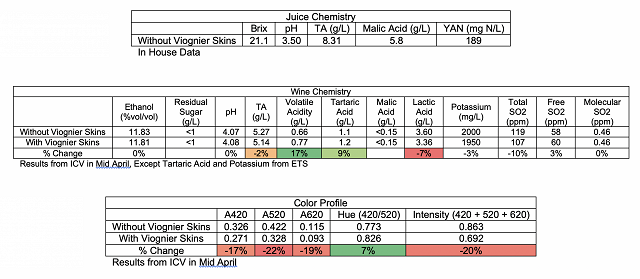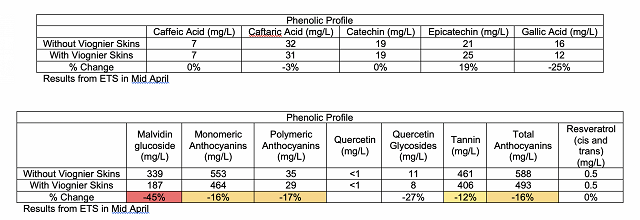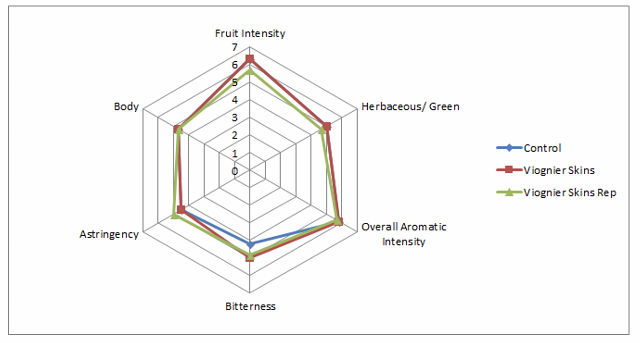The Impact of Adding Viognier Skins to Petit Verdot Fermentations (2017)
Milt and Sandy McPherson
Hunting Creek Vineyards
Summary and Introduction
This study examines whether adding Viognier skins to Petit Verdot fermentations alters the chemical and sensory qualities of the wine. The goal of adding Viognier skins was to mellow out some of the harsher characteristics of Petit Verdot. Petit Verdot grapes were crushed and split into two separate T Bins. To one bin, 10% w/w of Viognier skins were added (the skins were received a couple of days before processing Petit Verdot and were refrigerated prior to addition). An attempt was made to sort stems out of the Viognier skins. The other bin did not receive Viognier skins. All other treatments between wines were identical. Volatile acidity was slightly higher in the wine with Viognier skins. Color, and several phenolic parameters, were reduced in the Viognier skins treatment. For the triangle test, of 7 people who answered, 2 people chose the correct wine (29%), suggesting that the wines were not significantly different. No preference trends were discernible. For the descriptive analysis, there were no strong trends for the descriptors used in this study. The wines with Viognier skins had a slight tendency towards higher Bitterness, and perhaps higher Astringency. Although the chemistry suggests that the Viognier would reduce the tannic character of the wine, the sensory results suggest otherwise. More studies are needed in order to more fully evaluate the impact of adding white grape skins to red wine fermentations on chemical and sensory qualities.
Results and Discussion
Volatile acidity was slightly higher in the wine with Viognier skins. Color, and several phenolic parameters, were reduced in the Viognier skins treatment. For the triangle test, of 7 people who answered, 2 people chose the correct wine (29%), suggesting that the wines were not significantly different. No preference trends were discernible. For the descriptive analysis, there were no strong trends for the descriptors used in this study. The wines with Viognier skins had a slight tendency towards higher Bitterness, and perhaps higher Astringency. Although the chemistry suggests that the Viognier would reduce the tannic character of the wine, the sensory results suggest otherwise. The wines had a slight oxidative character, which may have masked some of the sensory distinctions between treatments. More studies are needed in order to more fully evaluate the impact of adding white grape skins to red wine fermentations on chemical and sensory qualities.



Methods
Petit Verdot grapes were harvested on September 9 from the same vineyard and block for both samples. The grapes were chilled overnight at 45°F and crushed the next day with equal amounts placed in two separate bins for fermentation. 20ppm potassium metabisulfite were added to each bin. To one bin, 10% (w/w) of Viognier skins, obtained from Horton Vineyards, were added and incorporated. These Viognier skins were received a couple of days before Petit Verdot processing (they had already been pressed off by Horton), and were refrigerated. An attempt was made to sort stems out of the Viognier skins. To each of the research bins Lalvin ICV D21 yeast with Go Ferm was added on September 11. Each bin had the cap punched down twice daily with additions of Fermaid K on September 13 and 17 with DAP addition on September 13.
The wine was pressed from the skins on September 20 using a vertical bladder press and racked September 21 to identical neutral Sylvain Grande Reserve M+T Bordeaux French oak barrels. MBR VP41 ML bacteria with ML Red Boost nutrient were added October 18. The light lees were stirred. Samples were obtained November 27 and sent to WRE project with the following results. Due to the elevated pH on the WRE analysis, tartaric acid 0.8 grams/ L was added to each barrel January 5. Final wine samples were taken in late April.
This wine was tasted on May 9. For the triangle test, descriptive analysis, and preference analysis, anybody who did not answer the form were removed from consideration for both triangle, degree of difference, and preference. Additionally, anybody who answered the triangle test incorrectly were removed from consideration for degree of difference and preference. Additionally, any data points for preference which did not make sense (such as a person ranking a wine and its replicate at most and least preferred, when they correctly guessed the odd wine) were removed.
In order to balance the data set to perform statistical analysis for descriptive analysis on the May 9 tasting, any judge who had not fully completed the descriptive analysis ratings were removed. In order to then make the number of judges between groups equivalent, one judge from from group 1 was eliminated. This resulted in a final data set of 3 groups, each with 2 judges (considered as replications within groups, and groups were considered as assessors). Data was analyzed using Panel Check V1.4.2. Because this is not a truly statistical set-up, any results which are found to be statistically significant (p<0.05) will be denoted as a “strong trend” or a “strong tendency,” as opposed to general trends or tendencies. The statistical significance here will ignore any other significant effects or interactions which may confound the results (such as a statistically significant interaction of Judge x Wine confounding a significant result from Wine alone). The descriptors used in this study were Fruit Intensity, Herbaceous/Green, Overall Aromatic Intensity, Bitterness, Astringency, and Body.
